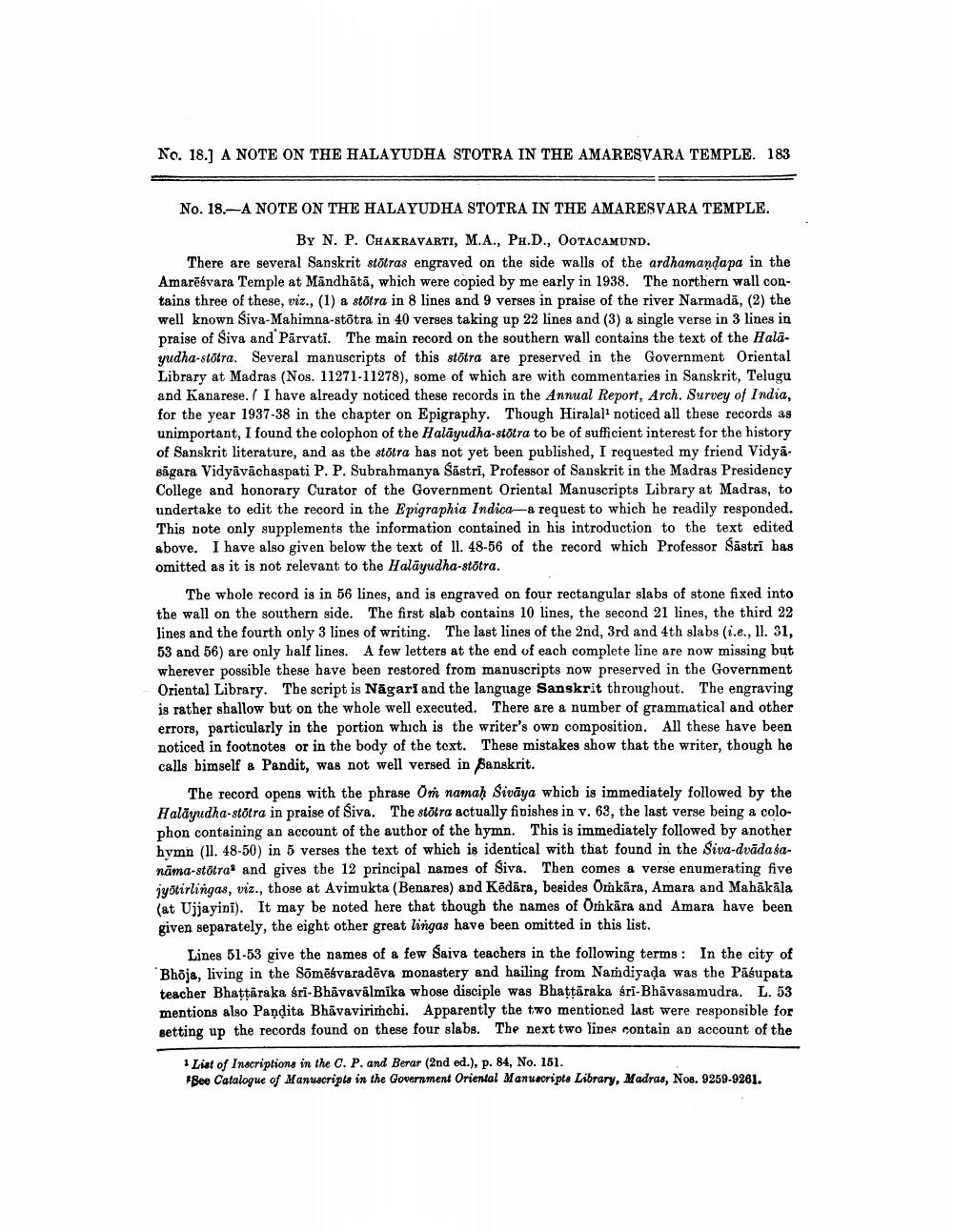________________
No. 18.) A NOTE ON THE HALAYUDHA STOTRA IN THE AMARESVARA TEMPLE. 183
No. 18.-A NOTE ON THE HALAYUDHA STOTRA IN THE AMARESVARA TEMPLE.
BY N. P. CHAKRAVARTI, M.A., Ph.D., OOTACAMUND. There are several Sanskrit stötras engraved on the side walls of the ardhamandapa in the Amarēsvara Temple at Māndhātā, which were copied by me early in 1938. The northern wall contains three of these, viz., (1) a stotra in 8 lines and 9 verses in praise of the river Narmadā, (2) the well known Siva-Mahimna-stõtra in 40 verses taking up 22 lines and (3) a single verse in 3 lines in praise of Siva and Parvati. The main record on the southern wall contains the text of the Halāyudha-stötra. Several manuscripts of this stotra are preserved in the Government Oriental Library at Madras (Nos. 11271-11278), some of which are with commentaries in Sanskrit, Telugu and Kanarese. / I have already noticed these records in the Annual Report, Arch. Survey of India, for the year 1937-38 in the chapter on Epigraphy. Though Hiralalnoticed all these records as unimportant, I found the colophon of the Halāyudha-stötra to be of sufficient interest for the history of Sanskrit literature, and as the stotra has not yet been published, I requested my friend Vidya. sāgara Vidyāvāchaspati P. P. Subrahmanya Sāstri, Professor of Sanskrit in the Madras Presidency College and honorary Curator of the Government Oriental Manuscripts Library at Madras, to undertake to edit the record in the Epigraphia Indica—a request to which he readily responded. This note only supplements the information contained in his introduction to the text edited above. I have also given below the text of Il. 48-56 of the record which Professor Sāstri has omitted as it is not relevant to the Halāyudha-stötra.
The whole record is in 56 lines, and is engraved on four rectangular slabs of stone fixed into the wall on the southern side. The first slab contains 10 lines, the second 21 lines, the third 22 lines and the fourth only 3 lines of writing. The last lines of the 2nd, 3rd and 4th slabs (i.e., 11. 31, 53 and 56) are only half lines. A few letters at the end of each complete line are now missing but wherever possible these have been restored from manuscripts now preserved in the Government Oriental Library. The script is Nāgari and the language Sanskrit throughout. The engraving is rather shallow but on the whole well executed. There are a number of grammatical and other errors, particularly in the portion which is the writer's own composition. All these have been noticed in footnotes or in the body of the text. These mistakes show that the writer, though he calls bimself & Pandit, was not well versed in Sanskrit.
The record opens with the phrase Om namah Sivāya which is immediately followed by the Halāyudha-stötra in praise of Siva. The stötra actually finishes in v. 63, the last verse being a colophon containing an account of the author of the hymn. This is immediately followed by another hymn (11. 48-50) in 5 verses the text of which is identical with that found in the Siva-dvāda sanama-stötra' and gives the 12 principal names of Siva. Then comes a verse enumerating five jyotirlingas, viz., those at Avimukta (Benares) and Kēdāra, besides Omkāra, Amara and Mahākāla (at Ujjayini). It may be noted here that though the names of Omkāra and Amara have been given separately, the eight other great lingas have been omitted in this list.
Lines 51-53 give the names of a few Saiva teachers in the following terms: In the city of Bhoja, living in the Sõmēsvaradēva monastery and hailing from Nandiyada was the Pasupata teacher Bhattāraka sri-Bhāvavālmika whose disciple was Bhattāraka sri-Bhāvasamudra. L. 53 mentions also Pandita Bhāvavirimchi. Apparently the two mentioned last were responsible for setting up the records found on these four slabs. The next two lines contain an account of the
1 List of Inscriptions in the C. P. and Berar (2nd ed.), p. 84, No. 151. Bee Catalogue of Manuscripts in the Government Oriental Manuscripts Library, Madras, Nos. 9269-9261.




